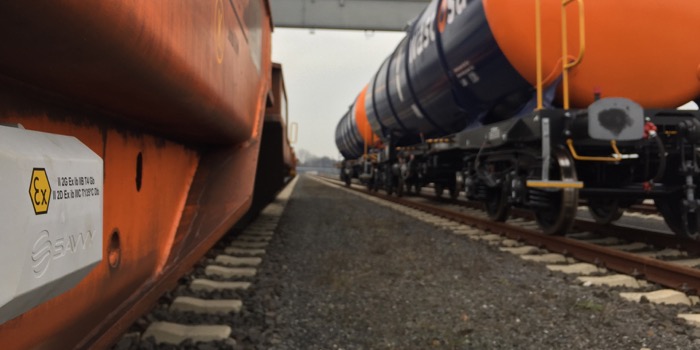SAVVY Telematic Systems and Wascosa introduce flat spot detection with telematics
Flat spots on freight wagon wheel sets are problematic. Not only do they lead to increased noise emissions, they also cause the wheel sets to wear out more quickly. In many cases, the flat spots are detected only after many kilometres on the rails, resulting in increased defects and costs. With the support of the Federal Office for the Environment (FOEN), the freight wagon leasing company Wascosa and SAVVY® Telematic Systems conducted a research project to analyse flat spot detection and developed a true innovation for rail freight transport.
The new development makes it possible to identify flat spots via acoustic irregularities and eliminate the flat spots efficiently. SAVVY’s newly developed flat spot algorithm evaluates the vibrations in the time and frequency range on the telematic system. The measured data is processed directly on the telematic system to calculate different indicators and is compared to historical data. If there is a flat spot on the wagon, this will influence the indicators and trigger an alarm signal.

The objective of the research project was to develop a reliable early detection system using telematic devices without the need of installing an external sensor system and transmitting information to the IT system environment via API interfaces.
When the project was launched, Wascosa had already equipped several hundred intermodal wagons with telematic systems developed by SAVVY Telematic Systems. This fleet of intelligent freight wagons constituted a solid foundation for the 1-year project’s proof of concept. With average kilometrage exceeding 100,000 km – even 200,000 km are not rare – intermodal wagons are some of the most intensely used freight wagons in the business. Correspondingly, flat spots will affect noise emissions.
Flat spots generate typical acoustic patterns. However, noise perception, especially as it pertains to trains, not only depends on the volume but also on the characteristics of a sound emission. While the sound of a passing freight train can be heard from quite a distance, it is not necessarily annoying; a flat spot on the other hand generates a distinct, unnatural periodic thumping sound.
During operations there are a lot of factors that have an effect on the wheel (imbalance, uneven running surfaces and infrastructure etc.) and the wagon (natural vibrations, load influences etc.). This leads to a wide range of different overlapping frequencies which are perceived as a “whooshing” sound. However, not every recurring vibration is a flat spot. Therefore it is important to find significant correlations between the measured data of the affected wagons and the dimensions of the flat spots on the wagon wheels.
For the whole duration of the research and development project, the SAVVY® CargoTrac-Ex telematic devices recorded innumerable parameters, such as e.g. accelerations in three axes (x, y, and z), the velocity or position of the Wascosa wagons. At SAVVY, big data analyses were conducted with the large amount of data collected from the Wascosa wagons to recognise flat spot patterns and develop reliable algorithms for flat spot detection.
The aim of the flat spot algorithm is to analyse, evaluate and transform the vibration parameters in the time and frequency range so that it generates significant and reliable indicators of the wagon’s dynamic vibration behaviour. The measured data is processed directly on the telematic system. The resulting indicators are recorded locally on the telematic system and compared with historical parameters. If there is a flat spot on the wagon, then an alarm is set off. The final algorithm was successfully integrated into the telematic firmware and rolled out on the Wascosa wagon fleet during the project. Initial applications for other SAVVY customers have confirmed the algorithm’s effectiveness: new flat spots were also reliably detected in that context.
The algorithms make the telematic device intelligent in such a way that notifications are only sent if needed. Transmission in 10 minute intervals e.g. is not required. In addition, the device’s battery-saving software intelligence ensures an autonomous lifecycle of up to 15 years.
Aida Kaeser, Chief Executive Officer SAVVY® Telematic Systems, said: “We are extremely pleased to have successfully brought this project with Wascosa to its roll-out phase. Our collaboration has demonstrated that Wascosa is an innovative partner. We would be happy to conduct other R&D projects with Wascosa, projects that will continue to make rail freight shipments more innovative and efficient.”
The measured data is processed directly on the SAVVY telematic system. The resulting indicators are recorded locally on the telematic system and compared with historical parameters. If there is a flat spot on the wagon, then an alarm is set off. The final algorithm was successfully integrated into the telematic firmware and rolled out on the Wascosa wagon fleet during the project. Initial applications for other SAVVY customers have confirmed the algorithm’s effectiveness: new flat spots were also reliably detected in that context.
For more information, visit: www.savvy-telematics.com
20th June 2018




















